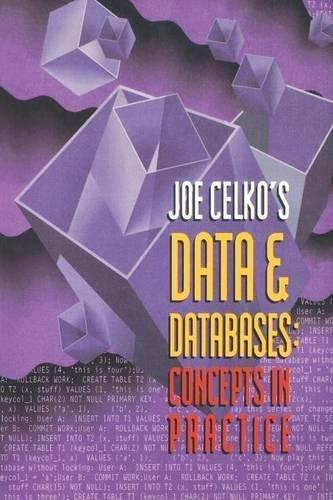Question
# NLP Assignment 2 (40% of grade): Vector Space Semantics for Similarity between Eastenders Characters In this assignment, you will be creating a vector representation
# NLP Assignment 2 (40% of grade): Vector Space Semantics for Similarity between Eastenders Characters
In this assignment, you will be creating a vector representation of a document containing lines spoken by a character in the Eastenders script data (i.e. from the file `training.csv`), then improving that representation such that each character vector is maximially distinguished from the other character documents. This distinction is measured by how well a simple information retrieval classification method can select documents from validation and test data as belonging to the correct class of document (i.e. deciding which character spoke the lines by measuring the similarity of those document vectors to those built in training).
As the lines are not evenly distributed in terms of frequency, this coursework stipulates you can only use a maximum of the first **400 lines** of each character in the training data to create the training documents, and a maximum of the first **40 lines** in the test data (from `test.csv`). This makes it more challenging, as number of lines spoken by a character can't be used directly or otherwise as a feature.
A simple vector representation for each character document is done for you to start with in this code, as is the pipeline of similarity based information retrieval based evaluation. You need to improve the character vector representations by pre-processing, feature extraction and transformation techniques, as per Questions 1-4 below, which you need to complete as instructed.
**Refer to the material in units 7-8 for conceptual background.**
# Q1. Improve pre-processing (10 marks) Using the pre-processing techniques you have learned in the module, improve the `pre_process` function above, which currently just tokenizes text based on white space.
When developing, use the 90% train and 10% validation data split from the training file, using the first 360 lines from the training split and first 40 lines from the validation split, as per above. To check the improvements by using the different techniques, use the `compute_IR_evaluation_scores` function as above. The **mean rank** is the main metric you need to focus on improving throughout this assignment, where the target/best possible performance is **1** (i.e. all test/validation data character documents are closest to their corresponding training data character documents) and the worst is **16**. Initially the code in this template achieves a mean rank of **5.12** and accuracy of **0.3125** on the test set- you should be looking to improve those, particularly getting the mean rank as close to 1 as possible.
# Q2. Improve linguistic feature extraction (15 marks) Use the feature extraction techniques you have learned to improve the `to_feature_vector_dictionary` function above. Examples of extra features could include extracting n-grams of different lengths and including POS-tags. You could also use sentiment analysis and gender classification (using the same data) as additional features.
You could use some feature selection/reduction with techniques like minimum document frequency and/or feature selection like k-best selection using different criteria https://scikit-learn.org/stable/modules/generated/sklearn.feature_selection.SelectKBest.html. Again, develop on 90% training and 10% validation split and note the effect/improvement in mean rank with the techniques you use.
# Q3. Add dialogue context data and features (15 marks) Adjust `create_character_document_from_dataframe` and the other functions appropriately so the data incorporates the context of the line spoken by the characters in terms of the lines spoken by other characters in the same scene (immediately before and after). You can also use **scene information** from the other columns **(but NOT the gender and character names directly)**.
# Q4. Improve the vectorization method (10 marks) Use a matrix transformation technique like TF-IDF (https://scikit-learn.org/stable/modules/generated/sklearn.feature_extraction.text.TfidfTransformer.html) to improve the `create_document_matrix_from_corpus` function, which currently only uses a dictionary vectorizor (`DictVectorizer`) which straight-forwardly maps from the feature dictionaries produced for each character document to a sparse matrix.
As the `create_document_matrix_from_corpus` is designed to be used both in training/fitting (with `fitting` set to `True`) and in transformation alone on test/validation data (with `fitting` set to `False`), make sure you initialize any transformers you want to try in the same place as `corpusVectorizer = DictVectorizer()` before you call `create_document_matrix_from_corpus`. Again, develop on 90% training 10% validation split and note the effect/improvement in mean rank with each technique you try.
# Q5. Select and test the best vector representation method (10 marks) Finish the optimization of your vector representations by selecting the best combination of the techniques you tried in Q1-3 and test using the code below to train on all of the training data (using the first 400 lines per character maximum) and do the final testing on the test file (using the first 40 lines per character maximum).
Make any neccessary adjustments such that it runs in the same way as the training/testing regime you developed above- e.g. making sure any transformer objects are initialized before `create_document_matrix_from_corpus` is called. Make sure your best system is left in the notebook and it is clear what the mean rank, accuracy of document selection are on the test data.
Step by Step Solution
There are 3 Steps involved in it
Step: 1

Get Instant Access to Expert-Tailored Solutions
See step-by-step solutions with expert insights and AI powered tools for academic success
Step: 2

Step: 3

Ace Your Homework with AI
Get the answers you need in no time with our AI-driven, step-by-step assistance
Get Started


